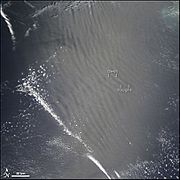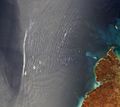Gravity wave facts for kids
Gravity waves are special waves that form in liquids or gases, like the ocean or the air around us. They are different from gravitational waves, which are ripples in space-time. Gravity waves get their name because the force of gravity (or buoyancy, which is like gravity pushing upwards) helps them move and keep their shape.
Contents
What are Gravity Waves?
Imagine dropping a pebble into a pond. The ripples that spread out are a type of gravity wave. These waves happen when a fluid, like water or air, is disturbed. Gravity then tries to pull the fluid back to its original flat or calm position. This pulling back and forth creates the wave motion.
How do Gravity Waves Form?
Gravity waves form because of two main things:
- Gravity: This force pulls things down. When a fluid is pushed up, gravity tries to pull it back down.
- Buoyancy: This is the upward push that fluids give to objects. If a fluid is pushed down, buoyancy tries to push it back up.
When a fluid is moved from its calm state, gravity and buoyancy work together to restore it. This constant trying to get back to normal creates the wave. Think of a pendulum swinging back and forth because gravity pulls it down, but its momentum carries it up again.
Where Can We See Gravity Waves?
Gravity waves are all around us, even if we don't always notice them. They are common in both the ocean and the atmosphere.
Gravity Waves in the Ocean
You see ocean gravity waves every day at the beach! These are the waves that break on the shore. They are created by wind blowing over the water. The wind pushes the water, and then gravity pulls it back down, causing the wave to travel.
- Ocean waves can travel long distances across the sea.
- They help mix the water, moving heat and nutrients around.
- Even tsunamis, which are giant waves caused by earthquakes, are a type of gravity wave.
Gravity Waves in the Atmosphere
Gravity waves also happen in the air. These are called atmospheric gravity waves. They form when air is pushed up or down, often by:
- Mountains: As wind blows over mountains, the air is forced upwards. When it comes down the other side, it can create waves in the air.
- Thunderstorms: Strong thunderstorms can create powerful updrafts and downdrafts that disturb the air, leading to gravity waves.
- Weather Fronts: Where warm and cold air masses meet, they can create disturbances that lead to these waves.
Atmospheric gravity waves can sometimes be seen as special cloud patterns, like "wave clouds" or "lenticular clouds," which look like stacks of lenses. These waves can affect local weather patterns and how air moves around the planet.
Why are Gravity Waves Important?
Gravity waves play a big role in how our planet works:
- Ocean Mixing: In the ocean, they help mix different layers of water. This is important for marine life and for distributing heat around the globe.
- Weather Patterns: In the atmosphere, gravity waves can influence how storms develop and how air currents move. They can even affect how much pollution stays in one place or gets spread out.
- Climate: By moving energy and momentum through the atmosphere and ocean, gravity waves are a key part of Earth's climate system. Scientists study them to better understand weather and climate change.
Images for kids
-
Wave clouds over Theresa, Wisconsin, United States in August 2005.
See also
 In Spanish: Onda de gravedad para niños
In Spanish: Onda de gravedad para niños





